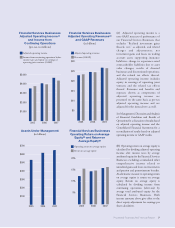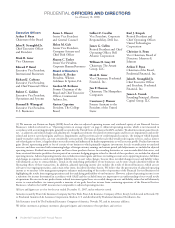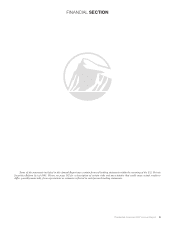Prudential 2007 Annual Report Download - page 18
Download and view the complete annual report
Please find page 18 of the 2007 Prudential annual report below. You can navigate through the pages in the report by either clicking on the pages listed below, or by using the keyword search tool below to find specific information within the annual report.• International Investments segment results improved in 2007, compared to 2006, primarily reflecting the gain from the sale of an
interest in operating joint ventures during 2007, higher income from market value changes on securities relating to exchange
memberships, and a benefit in 2007 from recoveries related to a former investment, as well as more favorable results in the
segment’s asset management businesses.
• Realized investment gains (losses), net, and related adjustments for the Financial Services Businesses in 2007 amounted to $106
million. Results for 2007 reflect gains on sales of equity securities primarily by our Japanese and Korean insurance operations,
partially offset by derivative losses and other-than-temporary impairments of fixed maturity and equity securities.
• Income from continuing operations before income taxes in the Closed Block Business decreased $113 million in 2007 compared to
2006. Results reflect an increase in dividends to policyholders resulting from an increase in the dividend scale, as well as an
increase in the cumulative earnings policyholder dividend obligation expense and claim costs that continue to increase with the
aging of the Closed Block policyholders, in addition to a reserve release in the prior year period. These items are partially offset by
increases in net realized investment gains and net investment income.
Accounting Policies & Pronouncements
Application of Critical Accounting Estimates
The preparation of financial statements in conformity with accounting principles generally accepted in the United States of America,
or U.S. GAAP, requires the application of accounting policies that often involve a significant degree of judgment. Management, on an
ongoing basis, reviews estimates and assumptions used in the preparation of financial statements. If management determines that
modifications in assumptions and estimates are appropriate given current facts and circumstances, results of operations and financial
position as reported in the Consolidated Financial Statements could change significantly.
The following sections discuss the accounting policies applied in preparing our financial statements that management believes are
most dependent on the application of estimates and assumptions.
Valuation of Investments
As prescribed by U.S. GAAP, we present our investments classified as available for sale, including fixed maturity and equity
securities, and our investments classified as trading, such as our trading account assets supporting insurance liabilities, at fair value in the
statements of financial position. The fair values for our public fixed maturity securities and our public equity securities are based on quoted
market prices or prices obtained from independent pricing services. However, for our investments in private securities such as private
placement fixed maturity securities, which comprise 14% of our investments as of December 31, 2007, this information is not available.
For these private fixed maturities, fair value is determined typically by using a discounted cash flow model, which relies upon the average
of spread surveys collected from private market intermediaries who are active in both primary and secondary transactions and takes into
account, among other factors, the credit quality of the issuer and the reduced liquidity associated with private placements. In determining
the fair value of certain securities, the discounted cash flow model may also use unobservable inputs, which reflect our own assumptions
about the inputs market participants would use in pricing the asset. See “—Realized Investment Gains and General Account Investments—
General Account Investments—Fixed Maturity Securities—Private Fixed Maturities—Credit Quality” and “—Realized Investment Gains
and General Account Investments—General Account Investments—Trading Account Assets supporting Insurance Liabilities” for
information regarding the credit quality of the private fixed maturity securities included in our general account.
For our investments classified as available for sale, the impact of changes in fair value is recorded as an unrealized gain or loss in
“Accumulated other comprehensive income (loss), net,” a separate component of equity. For our investments classified as trading, the
impact of changes in fair value is recorded within “Asset management fees and other income.” In addition, investments classified as
available for sale, as well as those classified as held to maturity, are subject to impairment reviews to identify when a decline in value is
other-than-temporary. Factors we consider in determining whether a decline in value is other-than-temporary include: the extent (generally
if greater than 20%) and duration (generally if greater than six months) of the decline; the reasons for the decline in value (credit event,
currency or interest rate related); our ability and intent to hold the investment for a period of time to allow for a recovery of value; and the
financial condition and near-term prospects of the issuer. When it is determined that a decline in value is other-than-temporary, the carrying
value of the security is reduced to its fair value, with a corresponding charge to earnings. In addition, for our impairment review of asset-
backed fixed maturity securities with a credit rating below AA, we forecast the prospective future cash flows of the security and determine
if the present value of those cash flows, discounted using the effective yield of the most recent interest accrual rate, has decreased from the
previous reporting period. When a decrease from the prior reporting period has occurred and the security’s market value is less than its
carrying value, the carrying value of the security is reduced to its fair value, with a corresponding charge to earnings. In both cases, this
corresponding charge to earnings is referred to as an impairment. Impairments are reflected in “Realized investment gains (losses), net” in
the statements of operations and are excluded from adjusted operating income. The new cost basis of an impaired security is not adjusted
for subsequent increases in estimated fair value. In periods subsequent to the recognition of an other-than-temporary impairment, the
impaired security is accounted for as if it had been purchased on the measurement date of the impairment. Accordingly, the discount (or
reduced premium) based on the new cost basis is accreted into net investment income, and included in adjusted operating income in future
periods based upon the amount and timing of the expected future cash flows of the security, if the recoverable value of the investment
based upon those cash flows is greater than the carrying value of the investment after the impairment. The level of impairment losses can
be expected to increase when economic conditions worsen and decrease when economic conditions improve. See “—Realized Investment
Gains and General Account Investments—Realized Investment Gains” for a discussion of the effects of impairments on our operating
results for the years ended December 31, 2007, 2006 and 2005.
16 Prudential Financial 2007 Annual Report
























